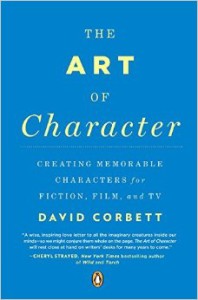Corbett, David (2013). The Art of Character: Creating Memorable Characters for Fiction Film, and TV. New York: Penguin. 383 pp.
This widely praised book is definitely worth reading, especially the first 120 pages, and the last 65, which are packed with insights. In the middle, the book degenerates into long, annotated lists without much analysis.
For example, Corbett cites The Art of Dramatic Writing, by Lajos Egri, which itemizes how to construct a character in terms of physical appearance, psychological traits, and sociological factors. Corbett spends the next 80 pages going over Egri’s list in detail that adds little to understanding. (Is your character comfortable with sex? Does your character have a good fashion sense? What are your character’s favorite foods? Does your character have strong political beliefs?). The point of this drawn-out exercise is to expand the range of choices you might consider when crafting a character, a worthy consideration, but one that’s swamped by tedious examples from books, TV, and movies. Do we really need to be reminded that James Joyce took seriously the religion of his characters?
Part III is another long list, this time of all the possible roles a character can take, such as protagonist, antagonist, the steadfast character, the sleepwalker, the ghost, the betrayer and other Joseph Campbell-y reductionistic stereotypes. There many other similar lists out there, about equally informative (e.g., Story Structure Architect, by V.L. Schmidt.)
So let’s look at the “good” 185 pages of the book, at the beginning and at the end. In the beginning section, Corbett starts with the classical, Aristotelian character arc but comes to a startling conclusion. Revelation of the character’s hidden weakness or Achilles’ Heel, does not result in epiphany, as Aristotle suggested, but in shame. This was a huge insight for me, and I realized that the whole notion of the epiphany is an intellectual artifice. Shame is a much more likely reaction. The character must then find a way to believe in his/her self-worth again to overcome that shame, or at least deal with it, as it’s not clear that shame can ever be undone.
Corbett’s discussion of secrets is likewise insightful. All characters have secrets, even secondary characters, and that’s a good way to animate a character and drive a story. Secrets produce contradictions: a hugely useful insight. The use of contradictory traits in the same character is an old trick, hard to do, but Corbett makes it seem reasonable and interesting with his examples (love v. duty, addiction v. propriety, poverty v. pretension, sex v. everything, etc.) He offers a fascinating analysis of forgiveness: is it really possible? What motivates it? Is it always only partial or limited, or qualified? I would have liked a lot more of that discussion.
The last section of the book is similarly filled with useful insight on how to write good scenes. One provocative challenge is to strip a scene down to pure exterior appearances and actions, yet still show, by implication, characters’ interiority. The tension between interior and exterior can be a powerful scene driver.
The section on “voice,” both the narrator’s and the character’s (often they are different) was disappointing, but perhaps there is nothing to say about voice. Everybody wants it but nobody can say what it is or how to get it. The section on dialog was only cursory, but there was a useful list of nuts-and-bolts craft techniques.
The exercises at the end of each chapter seemed formulaic, not well thought-out, but I imagine if you actually did them (I didn’t), they’d be helpful. The lessons of the book apply equally well to fiction, TV and movies, as the subtitle suggests, but aside from a brief and dubious discussion of the camera as narrator in visual storytelling, the book is not customized for screenwriting.
Overall, I’d say this book has useful reminders about what’s possible in developing character, something that prevents you from falling into a rut, and is spiced by a healthy dose of genuine insight into character development, and it all adds up to a compendium of information on the art of character that is well worth having.


Pingback: Mendocino Coast | Can't Stop Writing...